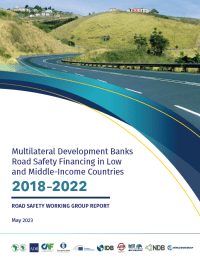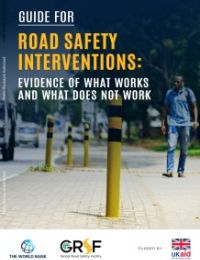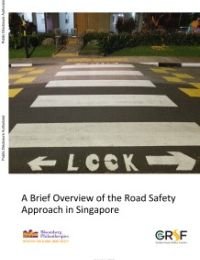Publications
1-3 of 3
-
Economics & Finance
Multilateral Development Banks Road Safety Financing in Low and Middle-Income Countries: 2018–2022
May 2023
-
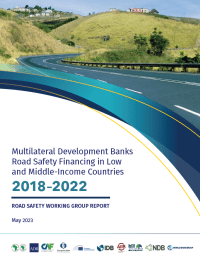
The Multilateral Development Banks (MDBs) Road Safety Working Group, established in 2009, is comprised of ten member institutions that are uniquely positioned to support countries in reaching their considerable and challenging road safety financing needs.
In early 2023, the working group reviewed progress made by the MDBs in financing road safety activities in low and middle-income countries (LMICs), and found that MDBs collectively committed $3.6 billion toward road safety initiatives in developing countries during the period 2018-2022. Three standalone road safety projects—in Bangladesh (World Bank), India (Asian Development Bank and World Bank), and Romania (European Investment Bank)—totaled $912 million in MDBs financing, which is more than one-quarter of the amount committed during this timeframe.
The review is based on details of road and urban mobility project financing provided by seven of the working group's ten members.
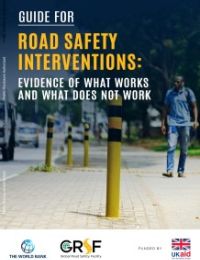
Road traffic crashes result in an estimated 1.35 million deaths and 50 million injuries worldwide per year with over 90 percent of these occurring in Low-Middle Income Countries (LMICs). Aside from the obvious pain and suffering this inflicts on individuals and communities, these deaths and injuries also place a large financial burden particularly on LMICs, by slowing economic growth.
The scale of the current response to this continuing crisis does not match the size of the problem. In addition, limited road safety resources are often expended on ineffective or suboptimal interventions. While road safety knowledge has improved over recent decades, there is still a need to improve decision making when selecting and applying effective evidence-based road safety interventions. Effective interventions are those that reduce fatal and serious injuries.
The World Bank's Global Road Safety Facility (GRSF) has developed this evidence-based guide on “What Works and What Does Not Work” in road safety in response to the critical need for effective evidence-based solutions.
This guide has been prepared to help readers understand that not all road safety interventions are equally effective and that what appear to be “common-sense” approaches to selecting road safety interventions will often not be the best. Although some provide benefits, others have very limited or even negative impacts, despite being commonly—and mistakenly—recommended or accepted. The guide offers a range of recommendations with a focus on interventions in LMICs, although the information may also be of relevance to all countries. The contents will be valuable to those working on road safety at policy or practitioner levels, including World Bank technical team leaders and others who seek to establish, expand, or improve road safety programs in LMICs.
The guide sets knowledge on evidence-based interventions within a “Safe System” context, providing advice on each of the Safe System pillars (road safety management, safe roads, safe speeds, safe vehicles, safe road users, and post-crash care) while recognizing that evidence-based solutions must be drawn from across pillars to produce effective road safety outcomes. At the core of this document is a summary table with an overview of beneficial and non-beneficial interventions based on sound scientific evidence. This is followed by more detailed information including case studies and references to the evidence base to support the summary.
Many safe road interventions are recommended for adoption, including integrated public transport, roadside and central barrier systems, medians, infrastructure to support appropriate operational speed for road users, roundabouts, grade separation and interventions to reduce exposure to risk at intersections, pedestrian footpaths and crossings, separated bicycle and motorcycle facilities, and traffic signs and line marking (including audio-tactile line marking). Some of these are highly effective, with up to a 70 or 80 percent reduction in fatalities and severe injuries (for example, safety barriers and roundabouts).
Various speed-related interventions also produce significant benefits, with some able to almost eliminate death and serious injury. Examples of effective speed interventions include traffic calming (including humps and chicanes), roundabouts, raised intersections and crossings, gateway treatments, lower speed limits (including 30 km/h (20 mph) zones for pedestrians) and speed cameras.
A variety of road user-based interventions have been implemented over many years, with effective examples including extensive supervised on-road practice and/or graduated licensing systems as part of the driver-licensing system, increased age for driving license eligibility, hazard perception training and testing, public education and campaigns as part of an integrated strategy (especially communicating enforcement to increase general deterrence), enforcement, penalties, alcohol interlocks, fatigue and speed monitoring, and increased helmet wearing rates.
Key vehicle-based interventions include applying minimum vehicle safety standards and vehicle ratings (through the Global New Car Assessment Program, or “NCAP”), seat belts, periodic vehicle maintenance, daytime running lights, under-run guards on trucks, Electronic Stability Control, and other advanced vehicle technologies.
Enhanced post-crash care can also produce better road safety outcomes, including systems to improve emergency response time, better emergency care, improved first aid skills for the public, and improved hospital care.
Equally important, the report also identifies clear examples where interventions are not effective. The worst of these are interventions that increase risk. These include increasing travel speed without improving quality of safety infrastructure, most forms of post-license driver and rider education and training, and many (but not all) forms of regular school-based driver education (such as those that seek to increase car-handling skills). The increase in risk is typically because such initiatives increase the level of confidence leading to an increase in risk taking. Other interventions that have no demonstrated safety benefits are to be avoided. These include license schemes through application or payment, training programs or education within schools that aim to improve road safety knowledge (including ad hoc visits by road safety experts or enthusiasts), and education campaigns conducted in isolation.
There are effective alternative interventions for each of these as described within this document, and these should be applied instead. It is extremely important that resources are not wasted on ineffective interventions on behalf of road safety but rather that evidence-based road safety interventions are employed.
There are a variety of documents available on the issue of road safety intervention effectiveness, many of which are referenced here. However, there are some key points of differences and added value in this guide, including a synthesis of the evidence on a broad range of interventions and a contrast between effective and noneffective interventions, allowing readers to compare options. Where noneffective interventions are identified, viable effective interventions are provided thereby supporting decision making. The guide also provides direct advice to those working in LMICs, drawing on key sources of information where this is available. Importantly, concise yet robust evidence is provided across each of the Safe System pillars.
There is a need to continue building the knowledge base on effective road safety interventions, particularly in LMICs where there are a number of gaps in knowledge. The contents of this guide represent a useful, up-to-date summary of current knowledge for application.
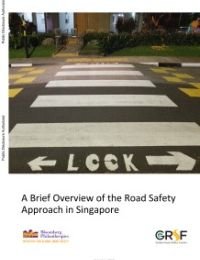
The report introduces how the Safe System Approach works, with a focus on road infrastructure and road safety engineering best practices from one of the best performing countries in Southeast Asia and the Pacific, Singapore.
Singapore roads are not only considered the safest in the region, they rank among the safest globally. Road safety management rules and regulations implemented in the country have resulted in significant strides in managing the effects of collision factors related to roadway design, human behavior, and vehicle attributes. As a result, road safety statistics have shown that fatalities on the Singapore road network have been steadily declining over the past decade. This is leading to a desire on the part of neighboring countries to follow Singapore's example and learn from its experience.
In order to mitigate collisions attributed to vehicle inadequacies or defects, one of the measures taken in Singapore was to enforce a strict vehicle import policy. Vehicle imports are permissible from countries that have adopted and comply with recognized high vehicle safety standards. Vehicle safety compliance is particularly focused on 52 items specified by the Land Transport Authority (LTA). In addition to strict vehicle import standards, Singapore enforces a strict vehicle quota system, which regulates the number of vehicles on the road network. Additionally, vehicles are required to undergo frequent inspections. Cars between 3 and 10 years old are required to have a biennial inspection, and cars older than 10 years are required to undergo annual inspections.
Furthermore, taxis are required to undergo inspections every six months. Road safety education and driver education are core tenants of Singapore's roads safety strategy. Road safety education is predominately undertaken by the Singapore Traffic Police, but nongovernmental organizations such as the National Security Coordination Secretariat contribute significantly to road safety education in Singapore.
Document also available in : Thai, Bahasa (Indonesian), Bahasa (Indonesian), Vietnamese

